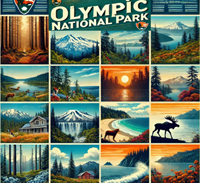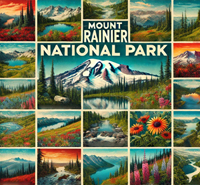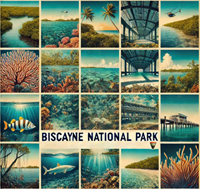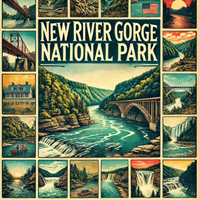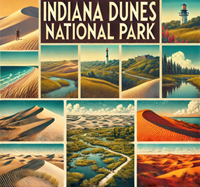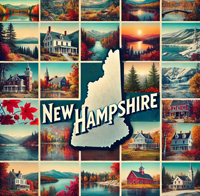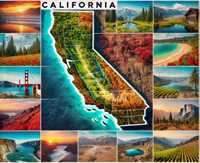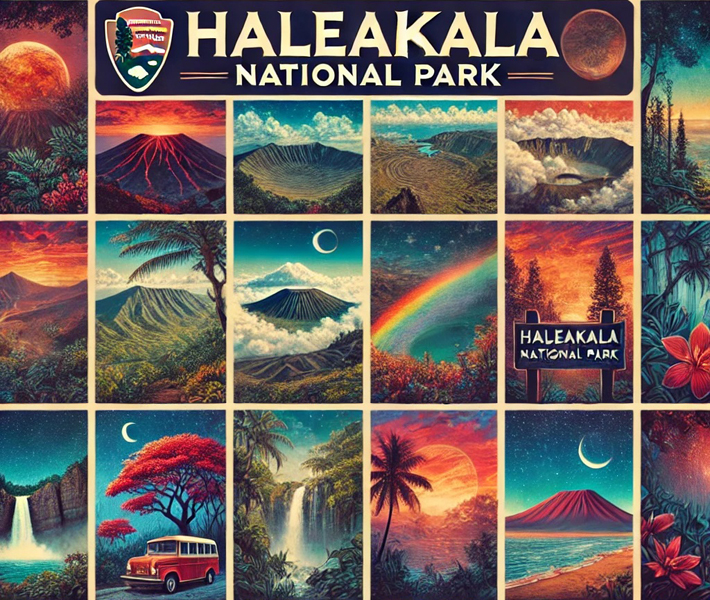
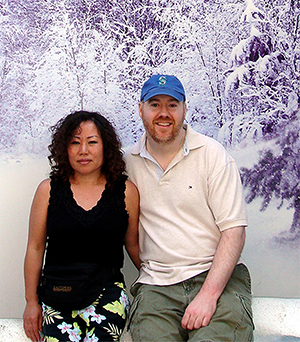
William and Hui Cha Stanek are passionate explorers and nature enthusiasts with a deep love for America's national parks. Over the years, they have journeyed across the country, immersing themselves in the stunning landscapes and diverse ecosystems that these parks have to offer. Their adventures are not just about the destinations but about the stories and connections they create along the way. Through their experiences, William and Hui Cha aim to inspire others to discover the beauty and tranquility that can be found in the natural world, and to foster a deep respect for the environment that sustains us all.
Each of William and Hui Cha's guides is introduced with artwork reflective of the destination. We prefer hand-crafted art over photographs because it offers a unique and personal touch. Each piece of art reflects our personal experience and artistic vision, inviting you to explore and connect with the destination in your own unique way. By showcasing the essence of a place through art, we encourage you to explore and discover its beauty for yourself, making your own memories along the way.
National Parks Index | US Itineraries Index | American Roadtrips Index
The Genesis of Our Art Panels: A Story of Inspiration and Unity
The journey of creating our art panels began with a singular vision: to capture the essence and spirit of each destination we explored. Each piece
of art you see in our panels started as a standalone artwork, inspired by a moment, a landscape, or a feeling that deeply resonated with us during our travels.
Our adventures took us to the farthest corners of America's national parks, where we immersed ourselves in the beauty and tranquility of nature.
From the rugged coastlines of Acadia to the majestic deserts of Canyonlands, each destination offered a unique story waiting to be told through our art.
The Creation Process
1. Individual Inspiration: Every journey starts with a single step, and for us, every art piece began with a single inspiration.
Whether it was the first light of dawn breaking over Cadillac Mountain or the serene reflection of Jordan Pond, we were moved to capture these
moments in their purest form. Hui Cha and I would often spend hours at a location, absorbing the atmosphere and letting the surroundings influence our creative process.
2. Capturing the Essence: Using a blend of traditional and digital mediums, we sought to translate the raw beauty of each scene
into a work of art. Hui Cha, with her keen eye for detail and texture, would focus on the intricate elements, while I would emphasize the broader,
sweeping landscapes. This collaborative effort ensured that each piece was a true reflection of our combined vision and artistic sensibilities.
3. The Evolution of a Single Work: Once an individual piece was completed, it stood alone as a testament to a specific moment in time.
These works were often shared with our community, each one telling a distinct story. However, we soon realized that while each piece was powerful on its own,
together, they could create a narrative that was even more compelling.
Bringing the Panels Together
1. Curating the Collection: We meticulously selected pieces that, when placed together, would tell a broader story of the destination.
Each panel was carefully curated to include a mix of landscapes, details, and moods, ensuring that the full spectrum of our experience was captured.
2. Designing the Layout: The arrangement of each panel was a deliberate and thoughtful process. We experimented with various
compositions, considering how each piece interacted with the others. The goal was to create a visual flow that would guide the viewer through
our journey, evoking the same emotions we felt when creating the art.
3. The Final Assembly: Once the layout was finalized, the individual works were brought together into a single panel. The
result was a harmonious blend of art that not only highlighted the beauty of the destination but also told the story of our exploration and the deep connection we felt with each place.
The Impact
These panels are more than just a collection of artworks; they are a window into our souls and our adventures. Each one invites you to
step into our shoes and experience the wonder and awe we felt in those moments. We hope that by sharing these panels, we can inspire you to embark on your own journeys, to find your own moments of beauty, and to create your own stories.
Bringing It Home
Our art panels are available for purchase at 360Studios.Pictorem.com, allowing
you to bring a piece of our journey into your home. Each panel serves as a unique treasure
, a beautiful reminder of the places we've explored and the memories we've created. By showcasing these panels, we aim to inspire a deeper
appreciation for the natural world and encourage the preservation of its beauty for future generations.

Bring home a Bugville Critters book and watch as your child's love for reading and learning grows with every page. Hand-painted illustrations bring the heartwarming stories to life. Ask your librarian to add Bugville Critters to the library's digital collection today!
Discover William Stanek's Exclusive Art Collection
Explore and purchase the stunning art featured on this site. Own a piece of William Stanek's unique and captivating artwork today!
(May 2, 2025) Exploring Oahu: A 5-Day Journey Through the Heart of Hawaii
Introduction: Discovering the Spirit and Beauty of Oahu
Oahu, known as "The Gathering Place," is an island that perfectly balances urban vibrancy with natural beauty. Home to the bustling city of Honolulu, iconic landmarks like Diamond Head, and some of the most famous beaches in the world, Oahu offers a diverse range of experiences. Whether you're surfing the waves at Waikiki, hiking through lush rainforests, or exploring the rich history of Pearl Harbor, this five-day itinerary will guide you through the best of what Oahu has to offer.
Each day of this journey will introduce you to a different side of Oahu, from the serene North Shore to the energetic heart of Honolulu. Let's embark on this adventure together, exploring the culture, history, and breathtaking landscapes that make Oahu a destination like no other.
Day 1: Arrival and Exploring Honolulu
Morning: Arrival in Honolulu
Overview
Your Oahu adventure begins as you arrive at Honolulu International Airport (Daniel K. Inouye International Airport). After picking up your rental car, head to your accommodation in Waikiki, the vibrant heart of Honolulu. Once you've settled in, take a moment to enjoy the views of Diamond Head and the Pacific Ocean from your hotel or vacation rental.
Tips from William
"Waikiki is a fantastic base for exploring Oahu. The energy of the area is contagious, and the views of Diamond Head from your accommodation are a great reminder of the adventures that lie ahead. If you have time, take a short walk to the beach to watch the surfers catch waves before heading out for the day."
Insights from Hui Cha
"Arriving in Honolulu feels like stepping into a vibrant and lively world. The sound of the ocean waves, the warm tropical breeze, and the sight of Diamond Head on the horizon create an immediate sense of excitement and anticipation for the journey ahead."
How to Access Waikiki
Directions:
- Honolulu International Airport is located about 10 miles from Waikiki. The drive to your accommodation takes about 20-30 minutes via H-1 Freeway East and Kalākaua Avenue.
Accommodation Details:
- Location: Waikiki, Honolulu, Oahu, HI
- Amenities: Many accommodations in Waikiki offer ocean views, proximity to beaches, and easy access to shops and restaurants.
Photography Tips: For the best shots of Waikiki, consider taking photos from your hotel balcony during the golden hour, when the light is soft and warm. A wide-angle lens will help you capture the panoramic views of the city and ocean.
Alternative Activity: If you arrive early and have time, consider visiting the Waikiki Beach Walk, where you can explore local shops, art galleries, and restaurants, and get a taste of the vibrant culture of Honolulu.
Mid-Morning: Visit to Pearl Harbor and USS Arizona Memorial
Overview
After settling in, head to Pearl Harbor, one of the most significant historical sites in the United States. The Pearl Harbor National Memorial includes several key attractions, including the USS Arizona Memorial, which honors the lives lost during the attack on Pearl Harbor on December 7, 1941. The visit begins with a short documentary film, followed by a boat ride to the memorial itself, where you can pay your respects and reflect on this pivotal moment in history.
Tips from William
"Pearl Harbor is a deeply moving place, and it's important to approach your photography with respect. Focus on capturing the solemnity and significance of the site. A wide-angle lens can help you capture the full scope of the memorial, while a telephoto lens is useful for close-ups of the names engraved on the wall."
Insights from Hui Cha
"Visiting Pearl Harbor is an emotional and reflective experience. The sight of the USS Arizona Memorial, the sound of the gentle waves lapping against the remains of the ship, and the knowledge of the history that unfolded here create a powerful connection to the past."
How to Access Pearl Harbor
Directions:
- Pearl Harbor is located about 10 miles northwest of Waikiki along H-1 Freeway West. The drive takes about 20 minutes, and parking is available on-site.
Memorial Details:
- Location: Pearl Harbor, Honolulu, Oahu, HI
- Difficulty: Easy (short walks with gentle terrain)
Photography Tips: For the best shots at Pearl Harbor, consider taking photos in the early morning or late afternoon when the light is softer. Be mindful of the other visitors and the respectful atmosphere of the memorial.
Alternative Activity: If you prefer a more interactive experience, consider visiting the USS Bowfin Submarine Museum & Park, where you can explore a World War II-era submarine and learn about the history of the U.S. Navy's submarine force.
Afternoon: Explore Downtown Honolulu and Iolani Palace
Overview
After your visit to Pearl Harbor, head to downtown Honolulu to explore the historic and cultural heart of the city. Start with a visit to Iolani Palace, the only royal palace in the United States, where you can learn about Hawaii's monarchy and its last reigning monarchs. Afterward, take a stroll through the downtown area, where you can visit the King Kamehameha Statue, Kawaiaha'o Church, and the Hawaii State Capitol.
Tips from William
"Downtown Honolulu is full of architectural and historical photography opportunities. Bring a wide-angle lens to capture the grandeur of Iolani Palace and the surrounding buildings, and a portrait lens for close-ups of the intricate details and statues."
Insights from Hui Cha
"Exploring downtown Honolulu is a journey into Hawaii's rich history and culture. The sight of Iolani Palace, the sound of the city's bustling streets, and the sense of being in the heart of Hawaii's political and cultural life create a deep connection to the island's past and present."
How to Access Downtown Honolulu and Iolani Palace
Directions:
- Downtown Honolulu is located about 3 miles northwest of Waikiki along Ala Moana Boulevard. The drive takes about 10 minutes, and parking is available in various public lots and garages.
Palace and Downtown Details:
- Location: Downtown Honolulu, Oahu, HI
- Difficulty: Easy (walking through urban areas with gentle terrain)
Photography Tips: For the best shots in downtown Honolulu, focus on capturing the contrast between the historic buildings and the modern skyline. A tripod can help stabilize your camera for sharp images, especially in the low light of the afternoon.
Alternative Activity: If you're interested in art and culture, consider visiting the Honolulu Museum of Art, where you can explore a diverse collection of Asian, Pacific, and Western art, including works that highlight Hawaii's unique cultural heritage.
Evening: Sunset at Magic Island
Overview
End your day with a sunset visit to Magic Island, a man-made peninsula located at Ala Moana Beach Park. Magic Island offers stunning views of the sunset over the Pacific Ocean, with the Honolulu skyline and Diamond Head in the background. It's a popular spot for both locals and visitors, making it a great place to relax and take in the beauty of Oahu's coast.
Tips from William
"Magic Island is a fantastic spot for sunset photography. Bring a wide-angle lens to capture the full scope of the beach, ocean, and skyline, and consider using a graduated neutral density filter to balance the exposure between the bright sky and the darker land."
Insights from Hui Cha
"Watching the sunset at Magic Island is a peaceful and awe-inspiring experience. The colors of the sky, the sound of the waves gently lapping on the shore, and the sight of the city lights beginning to twinkle in the distance create a perfect ending to your day in Honolulu."
How to Access Magic Island
Directions:
- Magic Island is located at Ala Moana Beach Park, about 2 miles west of Waikiki along Ala Moana Boulevard. The park has ample parking, but it can fill up quickly, so it's best to arrive early.
Beach Details:
- Location: Magic Island, Honolulu, Oahu, HI
- Difficulty: Easy
Photography Tips: For the best sunset shots at Magic Island, position yourself near the water's edge to capture the reflections in the sand and the waves as they come in. Use a small aperture (f/16 or smaller) to keep the entire scene in focus, and experiment with different compositions to highlight the layers and textures of the sky and sea.
Alternative Activity: If Magic Island is too crowded, consider heading to nearby Ala Moana Beach, where you can enjoy equally beautiful views of the sunset in a more secluded setting.
Day 2: Exploring the North Shore – Surfing, Shrimp Trucks, and Scenery
Early Morning: Drive to the North Shore and Sunrise at Laniakea Beach
Overview
On your second day, leave the city behind and head to Oahu's legendary North Shore, a region known for its world-class surfing, stunning beaches, and laid-back atmosphere. Start your day with a sunrise visit to Laniakea Beach, also known as "Turtle Beach," where you can watch the sun rise over the ocean and perhaps spot some Hawaiian green sea turtles basking on the shore.
Tips from William
"Laniakea Beach is perfect for wildlife and landscape photography. Bring a telephoto lens to capture close-up shots of the turtles and a wide-angle lens for the expansive views of the beach and ocean. The best light for photography is in the early morning when the sun is low in the sky, casting soft light on the water and sand."
Insights from Hui Cha
"Watching the sunrise at Laniakea Beach is a peaceful and rejuvenating experience. The sight of the sun rising over the ocean, the sound of the waves gently lapping on the shore, and the chance to see Hawaiian green sea turtles create a perfect start to your day on the North Shore."
How to Access Laniakea Beach
Directions:
- Laniakea Beach is located about 30 miles northwest of Honolulu along Kamehameha Highway (Hwy 83). The drive takes about 45 minutes, and parking is available on the side of the highway.
Beach Details:
- Location: Laniakea Beach, North Shore, Oahu, HI
- Difficulty: Easy
Photography Tips: For the best shots at Laniakea Beach, position yourself near the water's edge to capture the reflections in the sand and the waves as they come in. Use a small aperture (f/16 or smaller) to keep the entire scene in focus, and experiment with different compositions to highlight the layers and textures of the landscape.
Alternative Activity: If Laniakea Beach is too crowded or if you'd like to start your morning with a different view, consider heading to Sunset Beach, another beautiful spot on the North Shore known for its early morning tranquility and stunning vistas.
Mid-Morning: Explore Waimea Bay and Waimea Valley
Overview
After your sunrise experience, continue your exploration of the North Shore with a visit to Waimea Bay, one of the most famous surfing spots in the world. During the winter months, the bay is known for its massive waves, attracting professional surfers from around the globe. In the summer, the water is calm and perfect for swimming and snorkeling. Afterward, head to nearby Waimea Valley, a lush botanical garden and cultural site that offers a peaceful walk through tropical gardens leading to a waterfall where you can take a refreshing swim.
Tips from William
"Waimea Bay and Waimea Valley offer incredible opportunities for landscape and cultural photography. Bring a wide-angle lens to capture the expansive views of the bay and gardens, and a telephoto lens for close-ups of the surfers, plants, and waterfall. The best light for photography is in the mid-morning when the sun is high enough to illuminate the bay and valley but not too harsh."
Insights from Hui Cha
"Exploring Waimea Bay and Waimea Valley is a journey into the natural beauty and cultural heritage of the North Shore. The sight of the surfers riding the waves, the sound of the waterfall cascading into the pool, and the views of the lush gardens create a sense of awe and connection to the island's spirit."
How to Access Waimea Bay and Waimea Valley
Directions:
- Waimea Bay and Waimea Valley are located about 5 miles west of Laniakea Beach along Kamehameha Highway (Hwy 83). Both sites have parking available on-site, but it can fill up quickly, so it's best to arrive early.
Beach and Valley Details:
- Location: Waimea Bay and Waimea Valley, North Shore, Oahu, HI
- Difficulty: Easy to Moderate (depending on activities)
Photography Tips: For the best shots at Waimea Bay, position yourself near the shore to capture the surfers in action and the waves crashing on the beach. In Waimea Valley, focus on capturing the contrast between the lush vegetation and the waterfall. A tripod can help stabilize your camera for sharp images, especially in the low light under the forest canopy.
Alternative Activity: If the hike to Waimea Falls sounds too challenging, consider taking a shorter walk through the botanical gardens or exploring the beach at Waimea Bay, where you can relax and enjoy the stunning views of the ocean.
Afternoon: Lunch at a Shrimp Truck and Explore Haleiwa Town
Overview
After your morning of exploration, treat yourself to a classic North Shore experience with lunch at one of the area's famous shrimp trucks. These roadside eateries are known for their delicious garlic shrimp plates, a must-try when visiting the North Shore. After lunch, head to Haleiwa Town, a charming surf town filled with local shops, art galleries, and cafes. Take some time to stroll through the town, where you can shop for unique souvenirs, enjoy some shave ice, and soak in the laid-back atmosphere.
Tips from William
"Haleiwa Town is a great place for street and documentary photography. Bring a portrait lens to capture the details of the town's architecture and the people you meet, and a wide-angle lens for environmental portraits that include the surrounding landscape."
Insights from Hui Cha
"Exploring Haleiwa Town is a fun and engaging experience. The sight of the colorful storefronts, the sound of music and conversation in the cafes, and the opportunity to shop for unique souvenirs create a perfect afternoon on the North Shore."
How to Access Shrimp Trucks and Haleiwa Town
Directions:
- Shrimp trucks can be found along Kamehameha Highway (Hwy 83), particularly near Kahuku, about 10 miles east of Waimea Bay. Haleiwa Town is located about 3 miles south of Waimea Bay along Kamehameha Highway.
Town and Lunch Details:
- Location: Haleiwa, North Shore, Oahu, HI
- Difficulty: Easy
Photography Tips: For the best shots in Haleiwa Town, focus on capturing the town's unique blend of Hawaiian culture and surf culture. A tripod can help stabilize your camera for sharp images, especially in the low light of the afternoon.
Alternative Activity: If you prefer a more active afternoon, consider taking a surfing lesson at Haleiwa Beach Park, where you can ride the waves and enjoy the beautiful scenery of the North Shore.
Evening: Sunset at Sunset Beach
Overview
End your day with a sunset visit to Sunset Beach, one of the most famous beaches on the North Shore. Known for its stunning sunsets and powerful waves, Sunset Beach is the perfect spot to relax and watch the sun dip below the horizon. Bring a blanket and some snacks, and enjoy a peaceful evening on the beach, reflecting on the beauty of your day on Oahu's North Shore.
Tips from William
"Sunset Beach is a fantastic spot for sunset photography. Bring a wide-angle lens to capture the full scope of the beach and ocean, and consider using a graduated neutral density filter to balance the exposure between the bright sky and the darker land."
Insights from Hui Cha
"Watching the sunset at Sunset Beach is a peaceful and awe-inspiring experience. The colors of the sky, the sound of the waves gently lapping on the shore, and the sight of the surfers catching the last waves of the day create a perfect ending to your day on the North Shore."
How to Access Sunset Beach
Directions:
- Sunset Beach is located about 4 miles west of Waimea Bay along Kamehameha Highway (Hwy 83). The beach has limited parking, so it's best to arrive early.
Beach Details:
- Location: Sunset Beach, North Shore, Oahu, HI
- Difficulty: Easy
Photography Tips: For the best sunset shots at Sunset Beach, position yourself near the water's edge to capture the reflections in the sand and the waves as they come in. Use a small aperture (f/16 or smaller) to keep the entire scene in focus, and experiment with different compositions to highlight the layers and textures of the sky and sea.
Alternative Activity: If Sunset Beach is too crowded, consider heading to nearby Ehukai Beach, where you can enjoy equally beautiful views of the sunset in a more secluded setting.
Day 3: Exploring the Windward Coast – Beaches, Mountains, and Kaneohe Bay
Early Morning: Sunrise at Lanikai Beach
Overview
On your third day, head to Oahu's Windward Coast, a region known for its stunning beaches, lush mountains, and peaceful atmosphere. Start your day with a sunrise visit to Lanikai Beach, often ranked as one of the most beautiful beaches in the world. The soft white sand, clear turquoise waters, and the Mokulua Islands in the distance make Lanikai a perfect spot to watch the sun rise over the Pacific Ocean.
Tips from William
"Lanikai Beach is perfect for seascape and sunrise photography. Bring a wide-angle lens to capture the full scope of the beach and ocean, and a telephoto lens for close-up shots of the Mokulua Islands and the waves. The best light for photography is in the early morning when the sun is low in the sky, casting soft light on the water and sand."
Insights from Hui Cha
"Watching the sunrise at Lanikai Beach is a peaceful and rejuvenating experience. The sight of the sun rising over the ocean, the sound of the waves gently lapping on the shore, and the feel of the soft sand beneath your feet create a perfect start to your day on Oahu's Windward Coast."
How to Access Lanikai Beach
Directions:
- Lanikai Beach is located about 20 miles northeast of Honolulu along Kailua Road and Mokulua Drive. The drive takes about 30 minutes, and parking is available on the residential streets near the beach.
Beach Details:
- Location: Lanikai Beach, Windward Coast, Oahu, HI
- Difficulty: Easy
Photography Tips: For the best shots at Lanikai Beach, position yourself near the water's edge to capture the reflections in the sand and the waves as they come in. Use a small aperture (f/16 or smaller) to keep the entire scene in focus, and experiment with different compositions to highlight the layers and textures of the landscape.
Alternative Activity: If Lanikai Beach is too crowded or if you'd like to start your morning with a different view, consider heading to nearby Kailua Beach, another beautiful spot on the Windward Coast known for its early morning tranquility and stunning vistas.
Mid-Morning: Hike to Lanikai Pillboxes or Visit Hoʻomaluhia Botanical Garden
Overview
After your sunrise experience, embark on a hike to the Lanikai Pillboxes (Kaiwa Ridge Trail), a short but rewarding trail that offers panoramic views of Lanikai Beach, Kailua, and the Mokulua Islands. The trail takes you up to two World War II-era pillboxes (bunkers) that now serve as popular viewpoints. If you prefer a more relaxed morning, visit the Hoʻomaluhia Botanical Garden, a lush and tranquil garden located at the base of the Koʻolau Mountains, where you can enjoy a leisurely walk through tropical landscapes and take in stunning mountain views.
Tips from William
"The Lanikai Pillbox hike offers incredible opportunities for landscape photography. Bring a wide-angle lens to capture the expansive views of the coast and islands, and a telephoto lens for close-ups of the pillboxes and vegetation. The best light for photography is in the mid-morning when the sun is high enough to illuminate the landscape but not too harsh."
Insights from Hui Cha
"Hiking to the Lanikai Pillboxes is a journey into the natural beauty and history of the Windward Coast. The sight of the turquoise waters, the sound of the wind rustling through the trees, and the views of the Mokulua Islands create a sense of awe and connection to the island's spirit."
How to Access the Lanikai Pillboxes and Hoʻomaluhia Botanical Garden
Directions:
- The Lanikai Pillbox Trailhead is located near Lanikai Beach along Kaʻelepulu Drive. Hoʻomaluhia Botanical Garden is located about 5 miles west of Lanikai Beach along Luluku Road in Kaneohe.
Trail and Garden Details:
- Trail Length: 1.6 miles round-trip (to the second pillbox)
- Elevation Gain: 600 feet
- Difficulty: Moderate
- Botanical Garden: Easy (self-guided tour with gentle walking paths)
Photography Tips: For the best shots along the Lanikai Pillbox Trail, focus on capturing the contrast between the rugged cliffs and the ocean. A polarizing filter can help reduce glare from the water and enhance the colors of the vegetation. In the botanical garden, use a macro lens to capture the details of the tropical plants and flowers.
Alternative Activity: If the Lanikai Pillbox hike sounds too strenuous, consider taking a shorter walk through the botanical garden or exploring Kailua Beach, where you can relax and enjoy the stunning views of the ocean.
Afternoon: Explore Byodo-In Temple and Kaneohe Bay
Overview
In the afternoon, continue your exploration of the Windward Coast with a visit to the Byodo-In Temple, a stunning replica of a 900-year-old Buddhist temple in Japan. The temple is set against the backdrop of the Koʻolau Mountains and features a large reflecting pond, meditation gardens, and a towering Buddha statue. After your visit, head to Kaneohe Bay, where you can take a boat tour or kayak to the famous Kaneohe Sandbar, a unique offshore sandbar that appears during low tide and offers stunning views of the bay and surrounding mountains.
Tips from William
"The Byodo-In Temple is perfect for architectural and landscape photography. Bring a wide-angle lens to capture the full scope of the temple and gardens, and a telephoto lens for close-ups of the Buddha statue and intricate details of the temple. The best light for photography is in the early afternoon when the sun is high enough to illuminate the temple but not too harsh."
Insights from Hui Cha
"Exploring the Byodo-In Temple and Kaneohe Bay is a journey into the spiritual and natural beauty of the Windward Coast. The sight of the temple reflecting in the pond, the sound of the wind rustling through the trees, and the views of the sandbar create a sense of peace and connection to the island's culture and landscape."
How to Access Byodo-In Temple and Kaneohe Bay
Directions:
- The Byodo-In Temple is located about 4 miles northwest of Kailua along Kamehameha Highway (Hwy 83). Kaneohe Bay is located about 3 miles north of the temple along Kāneʻohe Bay Drive.
Temple and Bay Details:
- Location: Kaneohe, Windward Coast, Oahu, HI
- Difficulty: Easy to Moderate (depending on activities)
Photography Tips: For the best shots at the Byodo-In Temple, focus on capturing the contrast between the vibrant colors of the temple and the lush green mountains. A tripod can help stabilize your camera for sharp images, especially in the low light under the forest canopy. At Kaneohe Bay, use a wide-angle lens to capture the expansive views of the sandbar and mountains.
Alternative Activity: If the visit to Kaneohe Bay sounds too strenuous, consider taking a scenic drive along the Windward Coast, where you can enjoy beautiful views of the ocean and mountains from the comfort of your car.
Evening: Dinner in Kailua and Sunset at Kailua Beach
Overview
End your day with a relaxing dinner in Kailua, where you can enjoy fresh, locally sourced cuisine at one of the town's many restaurants. After dinner, head to Kailua Beach, one of the most beautiful beaches on the island, to watch the sunset over the Pacific Ocean. Bring a blanket and some snacks, and enjoy a peaceful evening on the beach, reflecting on the beauty of your day on Oahu's Windward Coast.
Tips from William
"Kailua Beach is a great spot for sunset photography. Bring a wide-angle lens to capture the full scope of the beach and ocean, and consider using a graduated neutral density filter to balance the exposure between the bright sky and the darker land."
Insights from Hui Cha
"Watching the sunset at Kailua Beach is a peaceful and awe-inspiring experience. The colors of the sky, the sound of the waves gently lapping on the shore, and the sight of the Mokulua Islands in the distance create a perfect ending to your day on the Windward Coast."
How to Access Dinner and Sunset in Kailua
Directions:
- Kailua is located about 20 miles northeast of Honolulu along Kailua Road. The town is easily accessible by car, with several restaurants and shops located along the main road.
Dining Details:
- Location: Kailua, Windward Coast, Oahu, HI
- Cuisine: Hawaiian, seafood, international
Photography Tips: For the best sunset shots at Kailua Beach, position yourself near the water's edge to capture the reflections in the sand and the waves as they come in. Use a small aperture (f/16 or smaller) to keep the entire scene in focus, and experiment with different compositions to highlight the layers and textures of the sky and sea.
Alternative Activity: If you prefer a more casual evening, consider picking up some takeout from a local market and having a picnic on the beach while watching the sunset.
Day 4: Exploring the Leeward Coast – Beaches, Hikes, and History
Early Morning: Drive to the Leeward Coast and Sunrise at Ka'ena Point
Overview
On your fourth day, head to Oahu's Leeward Coast, a region known for its secluded beaches, rugged landscapes, and rich history. Start your day with a sunrise visit to Ka'ena Point, the westernmost tip of Oahu. The Ka'ena Point Trail is a scenic coastal hike that takes you to a remote and windswept point where you can watch the sun rise over the Pacific Ocean. The area is also a wildlife sanctuary, home to nesting seabirds and Hawaiian monk seals.
Tips from William
"Ka'ena Point is perfect for wildlife and landscape photography. Bring a telephoto lens to capture close-up shots of the seabirds and seals, and a wide-angle lens for the expansive views of the coast and ocean. The best light for photography is in the early morning when the sun is low in the sky, casting soft light on the cliffs and water."
Insights from Hui Cha
"Watching the sunrise at Ka'ena Point is a peaceful and rejuvenating experience. The sight of the sun rising over the ocean, the sound of the waves crashing on the shore, and the chance to see Hawaiian monk seals create a perfect start to your day on Oahu's Leeward Coast."
How to Access Ka'ena Point
Directions:
- The Ka'ena Point Trailhead is located at the end of Farrington Highway (Hwy 930), about 40 miles northwest of Honolulu. The drive takes about 1 hour, and parking is available at the trailhead.
Trail Details:
- Trail Length: 5 miles round-trip (to Ka'ena Point)
- Elevation Gain: Minimal
- Difficulty: Moderate (due to rocky terrain)
Photography Tips: For the best shots along the Ka'ena Point Trail, focus on capturing the contrast between the rugged cliffs and the ocean. A polarizing filter can help reduce glare from the water and enhance the colors of the vegetation.
Alternative Activity: If the hike to Ka'ena Point sounds too challenging, consider taking a shorter walk along the Makua Beach, located just south of the trailhead, where you can enjoy beautiful views of the Leeward Coast without the effort.
Mid-Morning: Relaxation at Makaha Beach and Visit to Makua Cave
Overview
After your sunrise experience, continue your exploration of the Leeward Coast with a visit to Makaha Beach, a popular spot for swimming, snorkeling, and surfing. The beach is known for its clear waters, gentle waves, and beautiful views of the surrounding mountains. Afterward, head to nearby Makua Cave, a large sea cave located at the base of the Waianae Mountains. The cave offers a cool and shady retreat from the sun and a unique photo opportunity.
Tips from William
"Makaha Beach and Makua Cave offer incredible opportunities for landscape and seascape photography. Bring a wide-angle lens to capture the expansive views of the beach and ocean, and a telephoto lens for close-ups of the cave and waves. The best light for photography is in the mid-morning when the sun is high enough to illuminate the beach and cave but not too harsh."
Insights from Hui Cha
"Exploring Makaha Beach and Makua Cave is a journey into the natural beauty and history of the Leeward Coast. The sight of the turquoise waters, the sound of the waves gently lapping on the shore, and the views of the cave create a sense of awe and connection to the island's spirit."
How to Access Makaha Beach and Makua Cave
Directions:
- Makaha Beach is located about 5 miles south of Ka'ena Point along Farrington Highway (Hwy 930). Makua Cave is located about 2 miles south of Makaha Beach along the same highway.
Beach and Cave Details:
- Location: Makaha, Leeward Coast, Oahu, HI
- Difficulty: Easy to Moderate (depending on activities)
Photography Tips: For the best shots at Makaha Beach, position yourself near the water's edge to capture the reflections in the sand and the waves as they come in. In Makua Cave, use a tripod to stabilize your camera for long exposures and experiment with different compositions to highlight the layers and textures of the cave walls.
Alternative Activity: If the visit to Makua Cave sounds too strenuous, consider spending more time relaxing at Makaha Beach, where you can enjoy the beautiful views and gentle waves.
Afternoon: Explore Ko Olina and the Leeward Coast
Overview
In the afternoon, head to Ko Olina, a resort area located on the Leeward Coast that offers beautiful lagoons, luxury hotels, and a variety of recreational activities. Spend some time exploring the four man-made lagoons, where you can swim, snorkel, or simply relax on the beach. Ko Olina is also home to several high-end restaurants and shops, making it a great place to enjoy a leisurely afternoon and indulge in some retail therapy.
Tips from William
"Ko Olina is a great spot for beach and lifestyle photography. Bring a wide-angle lens to capture the full scope of the lagoons and ocean, and a telephoto lens for close-ups of the waves and marine life. The best light for photography is in the early afternoon when the sun is high enough to illuminate the beach and lagoons."
Insights from Hui Cha
"Exploring Ko Olina is a fun and relaxing experience. The sight of the turquoise lagoons, the sound of the waves gently lapping on the shore, and the opportunity to shop and dine create a perfect afternoon on Oahu's Leeward Coast."
How to Access Ko Olina
Directions:
- Ko Olina is located about 10 miles south of Makaha Beach along Farrington Highway (Hwy 930) and H-1 Freeway West. The resort area is well-signposted, and there is ample parking available.
Lagoon and Resort Details:
- Location: Ko Olina, Leeward Coast, Oahu, HI
- Difficulty: Easy
Photography Tips: For the best shots in Ko Olina, focus on capturing the contrast between the turquoise lagoons and the lush green vegetation. A tripod can help stabilize your camera for sharp images, especially in the low light under the trees.
Alternative Activity: If Ko Olina is too crowded, consider visiting nearby Kahe Point Beach Park (Electric Beach), a popular spot for snorkeling and scuba diving with vibrant coral reefs and abundant marine life.
Evening: Sunset at Kahe Point Beach Park
Overview
End your day with a sunset visit to Kahe Point Beach Park (Electric Beach), a popular spot for snorkeling and scuba diving on the Leeward Coast. The beach offers stunning views of the sunset over the Pacific Ocean, with the Waianae Mountains providing a dramatic backdrop. Bring a blanket and some snacks, and enjoy a peaceful evening on the beach, reflecting on the beauty of your day on Oahu's Leeward Coast.
Tips from William
"Kahe Point Beach Park is a fantastic spot for sunset photography. Bring a wide-angle lens to capture the full scope of the beach and ocean, and consider using a graduated neutral density filter to balance the exposure between the bright sky and the darker land."
Insights from Hui Cha
"Watching the sunset at Kahe Point Beach Park is a peaceful and awe-inspiring experience. The colors of the sky, the sound of the waves gently lapping on the shore, and the sight of the Waianae Mountains in the distance create a perfect ending to your day on the Leeward Coast."
How to Access Kahe Point Beach Park
Directions:
- Kahe Point Beach Park is located about 5 miles south of Ko Olina along Farrington Highway (Hwy 930). The beach has limited parking, so it's best to arrive early.
Beach Details:
- Location: Kahe Point Beach Park, Leeward Coast, Oahu, HI
- Difficulty: Easy
Photography Tips: For the best sunset shots at Kahe Point Beach Park, position yourself near the water's edge to capture the reflections in the sand and the waves as they come in. Use a small aperture (f/16 or smaller) to keep the entire scene in focus, and experiment with different compositions to highlight the layers and textures of the sky and sea.
Alternative Activity: If Kahe Point Beach Park is too crowded, consider heading to nearby Pokai Bay Beach Park, where you can enjoy equally beautiful views of the sunset in a more secluded setting.
Day 5: Farewell to Oahu – Exploring the South Shore
Morning: Visit to Hanauma Bay Nature Preserve
Overview
On your final day in Oahu, head to the South Shore to explore Hanauma Bay Nature Preserve, one of the most famous snorkeling spots in Hawaii. The bay is a protected marine life conservation area, home to vibrant coral reefs, colorful fish, and Hawaiian green sea turtles. Start your day with a snorkel session in the clear, calm waters of the bay, where you can explore the underwater world and see a variety of marine life up close.
Tips from William
"Hanauma Bay is perfect for underwater and marine life photography. Bring a waterproof camera or GoPro to capture the colorful fish and coral reefs. The best time for snorkeling is in the early morning when the water is calm and the visibility is at its best."
Insights from Hui Cha
"Snorkeling at Hanauma Bay is a peaceful and awe-inspiring experience. The sight of the vibrant coral, the feel of the warm ocean water, and the excitement of spotting a sea turtle create an unforgettable connection to Oahu's underwater world."
How to Access Hanauma Bay Nature Preserve
Directions:
- Hanauma Bay is located about 10 miles east of Waikiki along Kalanianaʻole Highway (Hwy 72). The drive takes about 20 minutes, and parking is available on-site.
Bay Details:
- Location: Hanauma Bay, South Shore, Oahu, HI
- Difficulty: Easy
Photography Tips: For the best shots at Hanauma Bay, position yourself near the coral reefs to capture the vibrant colors of the fish and marine life. Use a small aperture (f/16 or smaller) to keep the entire scene in focus, and experiment with different compositions to highlight the layers and textures of the underwater landscape.
Alternative Activity: If snorkeling isn't your thing, consider taking a scenic walk along the Hanauma Bay Ridge Trail, which offers stunning views of the bay and the surrounding coastline.
Mid-Morning: Explore Halona Blowhole and Sandy Beach
Overview
After snorkeling at Hanauma Bay, continue your exploration of the South Shore with a visit to the Halona Blowhole, a natural geyser that shoots seawater high into the air through a hole in the lava rock. The blowhole is located near Sandy Beach, a popular spot for bodyboarding and surfing. Take some time to watch the waves crash against the shore and enjoy the dramatic coastal scenery.
Tips from William
"Halona Blowhole and Sandy Beach are great spots for seascape photography. Bring a wide-angle lens to capture the full scope of the coastline and ocean, and a telephoto lens for close-ups of the blowhole and waves. The best light for photography is in the mid-morning when the sun is high enough to illuminate the coast but not too harsh."
Insights from Hui Cha
"Exploring Halona Blowhole and Sandy Beach is a journey into the wild and rugged beauty of the South Shore. The sight of the waves crashing against the cliffs, the sound of the blowhole erupting, and the views of the turquoise waters create a sense of awe and connection to the island's volcanic origins."
How to Access Halona Blowhole and Sandy Beach
Directions:
- The Halona Blowhole is located about 2 miles east of Hanauma Bay along Kalanianaʻole Highway (Hwy 72). Sandy Beach is located about 1 mile east of the blowhole along the same highway.
Blowhole and Beach Details:
- Location: Halona Blowhole and Sandy Beach, South Shore, Oahu, HI
- Difficulty: Easy
Photography Tips: For the best shots at Halona Blowhole, position yourself at a safe distance from the blowhole to capture the full scope of the water spout and the surrounding lava rock. Use a fast shutter speed to freeze the motion of the water, and experiment with different compositions to highlight the contrast between the dark rock and the bright ocean.
Alternative Activity: If Sandy Beach is too crowded, consider visiting nearby Makapu'u Beach, another beautiful spot on the South Shore known for its dramatic scenery and fewer crowds.
Afternoon: Lunch in Waimanalo and Explore Makapu'u Point
Overview
In the afternoon, head to Waimanalo, a small town located on the South Shore that offers beautiful beaches, local shops, and a laid-back atmosphere. Enjoy a relaxing lunch at one of the town's local eateries, where you can sample fresh, locally sourced cuisine. After lunch, take a short drive to Makapu'u Point, where you can hike the Makapu'u Point Lighthouse Trail, a scenic coastal trail that offers stunning views of the ocean and the surrounding cliffs.
Tips from William
"Makapu'u Point is a great spot for landscape photography. Bring a wide-angle lens to capture the full scope of the coastline and ocean, and a telephoto lens for close-ups of the lighthouse and cliffs. The best light for photography is in the early afternoon when the sun is high enough to illuminate the coast but not too harsh."
Insights from Hui Cha
"Exploring Makapu'u Point is a journey into the wild and rugged beauty of the South Shore. The sight of the turquoise waters, the sound of the waves crashing on the shore, and the views of the lighthouse create a sense of awe and connection to the island's natural beauty."
How to Access Waimanalo and Makapu'u Point
Directions:
- Waimanalo is located about 5 miles east of Sandy Beach along Kalanianaʻole Highway (Hwy 72). Makapu'u Point is located about 3 miles east of Waimanalo along the same highway.
Town and Trail Details:
- Trail Length: 2 miles round-trip (to the lighthouse)
- Elevation Gain: 500 feet
- Difficulty: Easy to Moderate
Photography Tips: For the best shots along the Makapu'u Point Lighthouse Trail, focus on capturing the contrast between the rugged cliffs and the ocean. A polarizing filter can help reduce glare from the water and enhance the colors of the vegetation.
Alternative Activity: If the hike to Makapu'u Point sounds too strenuous, consider taking a shorter walk along Waimanalo Beach, where you can relax and enjoy the stunning views of the ocean.
Evening: Farewell Dinner and Departure
Overview
End your final day on Oahu with a farewell dinner at one of the island's renowned restaurants, where you can enjoy fresh, locally sourced cuisine in a beautiful setting. After dinner, take a leisurely drive along the coast, reflecting on the incredible journey you've just experienced. Depending on your flight time, you may also have time for one last stroll along the beach or a quick visit to a local shop before heading to the airport.
Tips from William
"Oahu's restaurants offer a fantastic opportunity for food and lifestyle photography. Bring a portrait lens to capture the details of the dishes and the ambiance of the restaurant, and a wide-angle lens for environmental shots that include the surrounding scenery. The best time for photography is during the golden hour, just before sunset, when the light is warm and soft."
Insights from Hui Cha
"Having a farewell dinner on Oahu is a perfect way to end your journey. The taste of fresh, locally sourced cuisine, the sight of the setting sun over the ocean, and the memories of the incredible experiences you've had create a sense of peace and gratitude as you prepare to say goodbye to the island."
How to Access Farewell Dinner and Departure
Directions:
- Depending on your location on the island, choose a restaurant that offers both a great dining experience and easy access to your departure point. If you're staying on the South Shore, consider a restaurant in Waimanalo or Kailua for convenience. If you're in Waikiki or Honolulu, make sure to allow enough time for your drive to the airport after dinner.
Dining Details:
- Location: Oahu, HI (Various Locations)
- Cuisine: Farm-to-table, Hawaiian, international
Photography Tips: For the best shots during your farewell dinner, focus on capturing the ambiance of the restaurant and the details of the dishes. Experiment with different angles and lighting to highlight the textures and colors of the food, and use a shallow depth of field to create a beautiful bokeh effect that emphasizes the dish while softly blurring the background.
Alternative Activity: If you prefer a more casual evening, consider picking up some takeout from a local market and enjoying a picnic on the beach while watching the sunset. This relaxed option allows you to soak in the island's natural beauty one last time before heading to the airport.
Departure from Oahu
After dinner, take a leisurely drive to Honolulu International Airport, reflecting on the incredible journey you've just completed. As you travel along the coast, you'll have one final opportunity to take in the sights and sounds of the island. Arrive at the airport with enough time to return your rental car and check in for your flight, carrying with you the memories and experiences of your unforgettable trip to Oahu.
Conclusion: A Personal Reflection
As you leave Oahu behind and head home, take some time to reflect on the incredible journey you've just completed. From the vibrant energy of Waikiki to the serene beauty of the North Shore, this trip has been a reminder of the island's rich diversity, natural beauty, and deep cultural heritage.
These experiences are more than just memories – they are connections to the land, the people, and the spirit of Oahu. As you fly away from the island, carry with you the sense of awe, peace, and inspiration that this journey has brought, knowing that the beauty of this place will always be there, waiting for you to return.
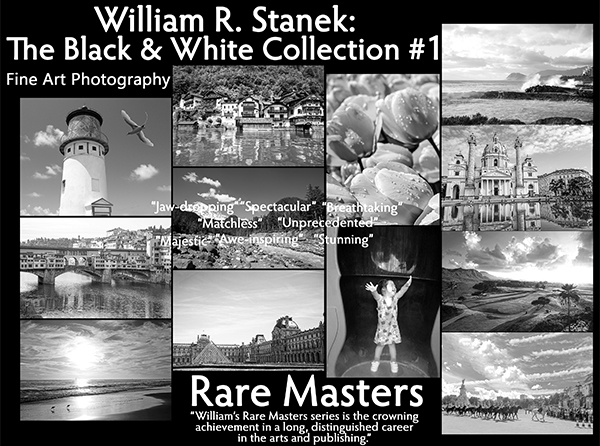
Step into a world of timeless beauty with our premium, oversized hardcover book - crafted for discerning collectors and anyone who values the power of art. Perfect for your coffee table, it's more than just a book; it's a conversation starter, a window into over 30 years of William's visionary photography.
Your Support Matters
Purchasing artwork from William Stanek's collection not only brings beauty into your life but also helps us continue to share. Thank you for supporting our creative journey!

Support The Lights of Paris by Robert Stanek, William Stanek's pen name! Through vivid historical detail and deeply moving character stories, Robert takes readers on an unforgettable journey through one of history’s most transformative times.


